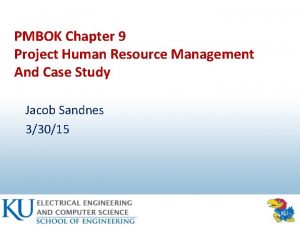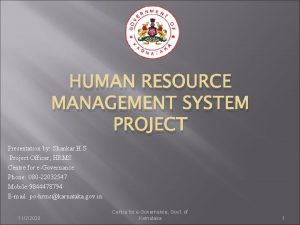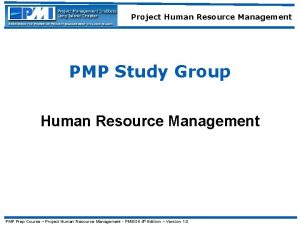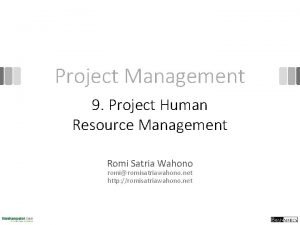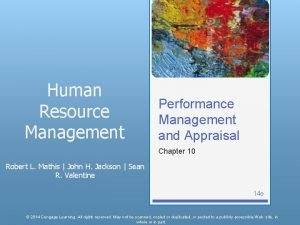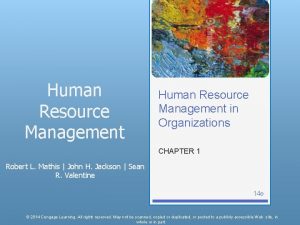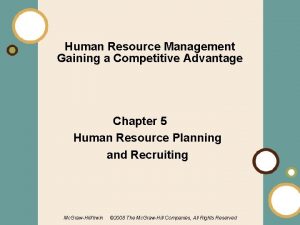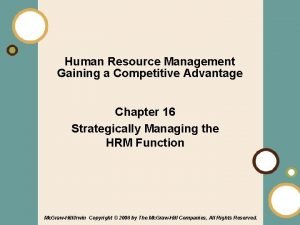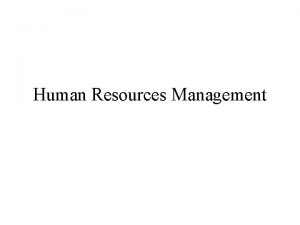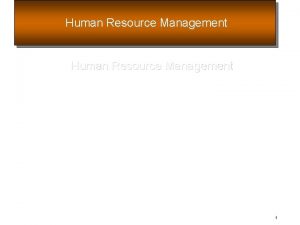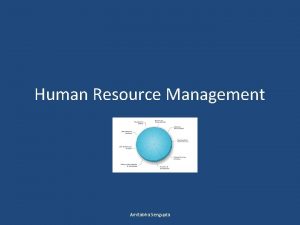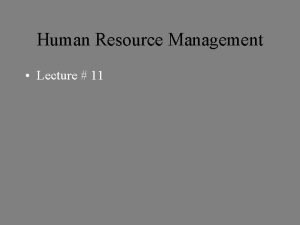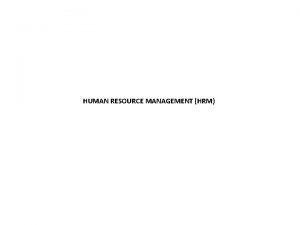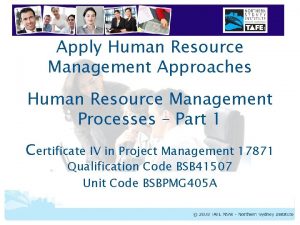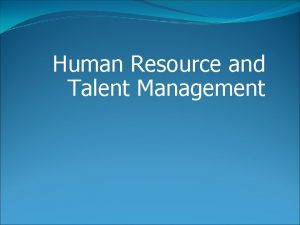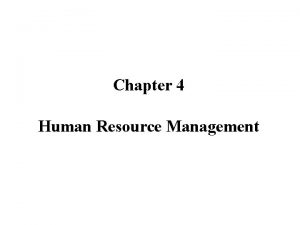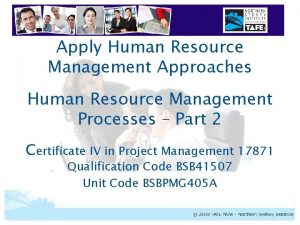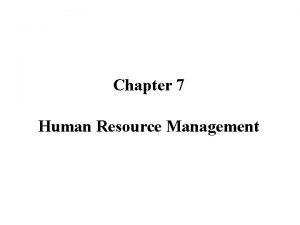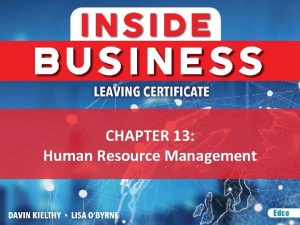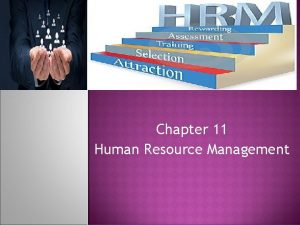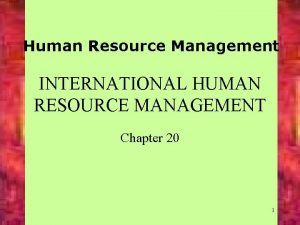Project Human Resources Management PROJECT HUMAN RESOURCE MANAGEMENT



























- Slides: 27


Project Human Resources Management

PROJECT HUMAN RESOURCE MANAGEMENT BY Engr. Dr. Attaullah Shah Ph. D (Civil Engg. ) , MSc ( Str Engg. ) , MBA , MA ( Eco) , MSc Envir design BSc Civil Engg (Gold Medal) , Post Grad Dip in computer ( Gold medal) Project Director Allama Iqbal Open University Islaamabad Pakisatn. pdaiou@yahoo. com pd@aiou. edu. pk Cell: +92 -333 -5729809 Tel: +92 -51 -9057212 Fax: +92 -51 -9250100

n Seek knowledge from cradle to grave. The Holy Prophet ( PBUH). n The only true wisdom is in knowing you know nothing" Socrates n What we have to learn to do, we learn by doing- Aristotle n Learn as if you were going to live forever. Live as if you were going to die tomorrow- Mahatma Gandhi n Stop thinking in terms of limitations and start thinking in terms of possibilities - Terry Josephson, 20 th/21 st-century motivational author. n The people who are crazy enough to think they can change the world are the ones who do- Steve Jobs, CEO of Apple. n The illiterate of the 21 st century will not be those who cannot read and write, but those who cannot learn, unlearn, and relearn'. Alvin Toffler n Many of life's failures are people who did not realize how close they were to success when they gave up- Thomas A. Edison

n 'It is impossible to begin to learn that which one thinks one already knows'. Epictetus n I am always doing that which I can not do, in order that I may learn how to do it. " Pablo Picasso n One of the greatest joys known to man is to take a flight into ignorance in search of knowledge. - Robert Lynd n n All our knowledge has its origins in our perceptions- Leonardo da Vinci We are what we repeatedly do. - Aristotle. n The final obstacle is the belief that there is an obstacle. – Papaji n Imagination is more important than knowledge. For while knowledge defines all we currently know and understand, imagination points to all we might yet discover and create- Einstein

Human Resource Strategy: A People-Centered Approach n n Human Resource Management (HRM) ¨ The proactive acquisition, retention, development, adjustment and managing changes of human resources necessary for organizational success. ¨ HRM has moved from a support staff function (personnel) to a more strategic role in organizations. Human Capital or Human Resource. n A term that recognizes the greater societal value of developing all present and future work force participants to their fullest potential. Is your HRD playing these functions. If No then Why?

People-Centered Organizations Enjoy a Competitive Advantage n People-centered Practices: ¨ Protection of job security ¨ Rigorous hiring process ¨ Employee empowerment ¨ Compensation linked to performance ¨ Comprehensive training ¨ Reduction of status differences ¨ Sharing of key information

HRM activities and Responsibilities of Line Manager and the HR Department Activity Staffing Retention Training & Development Line Manager Data for job, Min qualification, integrating strategic plans with HR plan, Interviewing candidates, making final decision on entry level hires and promotion Job Analysis HRP Recruitment & Selection Employees Laws and Regulations. Fair Treatment Open Communication, team work, performance based pay increases, Respect and dignity of employees. -Compensation and benefits. -Health and Safety -Employee Services. -On job training, -Dev legally sound performance Mangt. -Technical Training -Moral Surveys -Managerial and OD -HR research - Job enrichment, -Motivational strategies, -performance feedback to employees, -Coaching Adjustments -Discipline, -Discharge -Lay offs Managing Changes HRD - Investigate Employees Complaints. -Replacement Services -Retirement Counseling - Provide vision to unit as to where the - Provide expertise to manage the overall Organization is going? process of managing change.

Project Human Resource Management n Project Human Resource Management includes the processes that organize and manage the project team. n The project team is comprised of the people who have assigned roles and responsibilities for completing the project. While it is common to speak of roles and responsibilities being assigned, team members should be involved in much of the project’s planning and decision-making. n Early involvement of team members adds expertise during the planning process and strengthens commitment to the project. n The type and number of project team members can often change as the project progresses. n Project team members can be referred to as the project’s staff.

Project Human Resource Management processes n Human Resource Planning – Identifying and documenting project roles, responsibilities, and reporting relationships, as well as creating the staffing management plan. n Acquire Project Team – Obtaining the human resources needed to complete the project. n Develop Project Team – Improving the competencies and interaction of team members to enhance project performance. n Manage Project Team – Tracking team member performance, providing feedback, resolving issues, and coordinating changes to enhance project performance.


Human Resource Planning n Human Resource Planning determines project roles, responsibilities, and reporting relationships, and creates the staffing management plan. n Project roles can be designated for persons or groups. Those persons or groups can be from inside or outside the organization performing the project. n The staffing management plan can include how and when project team members will be acquired, the criteria for releasing them from the project, identification of training needs, plans for recognition and rewards, compliance considerations, safety issues, and the impact of the staffing management plan on the organization.

HR Planning

Human Resource Planning: Tools and Techniques n Organization Charts and Position Descriptions n Various formats exist to document team member roles and responsibilities. Most of the formats fall into one of three types hierarchical, ¨ Matrix, and ¨ text oriented. ¨

n Hierarchical-type charts. The traditional organization chart structure can be used to show positions and relationships in a graphic, top-down format. Work breakdown structures (WBS) that are primarily designed to show project deliverables are broken down into work packages become one way to show high-level areas of responsibility. n The organizational breakdown structure (OBS) looks similar to the WBS, but instead of being arranged according to a breakdown of project deliverables, it is arranged according to an organization’s existing departments, units, or teams. n The project activities or work packages are listed under each existing department. This way, an operational department such as information technology or purchasing can see all of its project responsibilities by looking at its portion of the OBS. n The resource breakdown structure (RBS) is another hierarchical chart. It is used to break down the project by types of resources. For example, an RBS can depict all of the welders and welding equipment being used in different areas of a ship even though they can be scattered among different branches of the OBS and WBS. The RBS is helpful in tracking project costs, and can be aligned with the organization’s accounting system. The RBS can contain resource categories other than human resources.

n Matrix-based charts. A responsibility assignment matrix (RAM) is used to illustrate the connections between work that needs to be done and project team members. n On larger projects, RAMs can be developed at various levels. For example a high-level RAM can define what project team group or unit is responsible for each component of the WBS, while lower-level RAMs are used within th group to designate roles, responsibilities, and levels of authority for specific activities. The matrix format, sometimes called a table, allows a person to s all activities associated with one person or to see all people associated with one activity. n RAM used for an IT Project

Human Resource Planning: Outputs 1. Roles and Responsibilities The following items should be addressed when listing the roles and responsibilities needed to complete the project: • Role. The label describing the portion of a project for which a person is accountable. Examples of project roles are civil engineer, court liaison, business analyst, and testing coordinator. Role clarity concerning authority, responsibilities, and boundaries is essential for project success. Authority. The right to apply project resources, make decisions, and sign approvals. Examples of decisions that need clear authority include the selection of a method for completing an activity, quality acceptance, and how to respond to project variances. Team members operate best when their individual levels of authority matches their individual responsibilities. Responsibility. The work that a project team member is expected to perform in order to complete the project’s activities. Competency. The skill and capacity required to complete project activities. If project team members do not possess required competencies, performance can be jeopardized. When such mismatches are identified, proactive responses such as training, hiring, schedule changes, or scope changes are initiated.

2. n n Project Organization Charts A project organization chart is a graphic display of project team members and their reporting relationships. It can be formal or informal, highly detailed or broadly framed, based on the needs of the project. For example, the project organization chart for a 3, 000 -person disaster response team will have greater detail than a project organization chart for an internal, twenty-person project. 3. Staffing Management Plan n The staffing management plan, a subset of the project management plan describes when and how human resource requirements will be met. The staffing management plan can be formal or informal, highly detailed or broadly framed, based on the needs of the project. The plan is updated continually during the project to direct ongoing team member acquisition and development actions. Information in the staffing management plan varies by application area and project size, but items to consider include: ¨ ¨ ¨ ¨ Staff acquisition. Timetable. Release criteria. Training needs. Recognition and rewards Compliance. Safety.

Acquire Project Team. n Acquire Project Team is the process of obtaining the human resources needed to complete the project. The project management team may or may not have control over team members selected for the project.

Acquire Project Team. Tools and Techniques n n n Pre-Assignment In some cases, project team members are known in advance; that is, they are pre-assigned. This situation can occur if the project is the result of specific people being promised as part of a competitive proposal, if the project is dependent on the expertise of particular persons, or if some staff assignments are defined within the project charter. Negotiation Staff assignments are negotiated on many projects. For example, the project management team may need to negotiate with: - Functional managers to ensure that the project receives appropriately competent staff in the required time frame, and that project team members will be able to work on the project until their responsibilities are completed - Other project management teams within the performing organization to appropriately assign scarce or specialized resources.

n n Acquisition When the performing organization lacks the in-house staff needed to complete the project, the required services can be acquired from outside sources. Virtual Teams The use of virtual teams creates new possibilities when acquiring project team members. Virtual teams can be defined as groups of people with a shared goal, who fulfill their roles with little or no time spent meeting face to face. The availability of electronic communication, such as e-mail and video conferencing, has made such teams feasible

Develop Project Team n n Develop Project Team improves the competencies and interaction of team members to enhance project performance. Objectives include: - Improve skills of team members in order to increase their ability to complete project activities - Improve feelings of trust and cohesiveness among team members in order to raise productivity through greater teamwork. n General Management Skills Interpersonal skills , sometimes known as “soft skills, ” are particularly important to team development. By understanding the sentiments of project team members, anticipating their actions, acknowledging their concerns, and following up on their issues, the project management team can greatly reduce problems and increase cooperation. Skills such as empathy, influence, creativity, and group facilitation are valuable assets when managing the project team. n Training includes all activities designed to enhance the competencies of the project team members. Training can be formal or informal. Examples of training methods include classroom, online, computer-based, on-the-job training from another project team member, mentoring, and coaching.

n Team-Building Activities Team-building activities can vary from a five-minute agenda item in a status review meeting to an off-site, professionally facilitated experience designed to improve interpersonal relationships. n Ground Rules Ground rules establish clear expectations regarding acceptable behavior by project team members. Early commitment to clear guidelines decreases is understandings and increases productivity.

n Co-Location Co-location involves placing many or all of the most active project team members in the same physical location to enhance their ability to perform as a team. Co -location can be temporary, such as at strategically important times during the project, or for the entire project. n Recognition and Rewards Part of the team development process involves recognizing and rewarding desirable behavior. The original plans concerning ways to reward people are developed during Human Resource Planning.

Manage Project Team n Manage Project Team involves tracking team member performance, providing feedback, resolving issues, and coordinating changes to enhance project performance. n The project management team observes team behavior, manages conflict, resolves issues, and appraises team member performance. n n As a result of managing the project team, the staffing management plan is updated, change requests are submitted, issues are resolved, input is given to organizational performance appraisals, and lessons learned are added to the organization’s database.

Manage Project Team: Tools and Techniques n Observation and Conversation Observation and conversation are used to stay in touch with the work and attitudes of project team members. The project management team monitors indicators such as progress toward project deliverables, accomplishments that are a source of pride for team members, and interpersonal issues. n Project Performance Appraisals The need formal or informal project performance appraisals depends on the length of the project, complexity of the project, organizational policy, labor contract requirements, and the amount and quality of regular communication. Project team members receive feedback from the people who supervise their project work. Evaluation information also can be gathered from people who interact with project team members by using 360 -degree feedback principles.

n Conflict Management Successful conflict management results in greater productivity and positive working relationships. Sources of conflict include scarce resources, scheduling priorities, and personal work styles. n Issue Log As issues arise in the course of managing the project team, a written log can document persons responsible for resolving specific issues by a target date. The log helps the project team monitor issues until closure.
 Resource management pmp
Resource management pmp Project human resource management pmbok
Project human resource management pmbok Hrms.shanker group
Hrms.shanker group Pmp roles and responsibilities
Pmp roles and responsibilities Human resource histogram
Human resource histogram Time management human resources
Time management human resources Retail human resources
Retail human resources Defintion of hrm
Defintion of hrm Resource leveling is the approach to even out the peaks of
Resource leveling is the approach to even out the peaks of Perbedaan antara resource loading dan resource levelling
Perbedaan antara resource loading dan resource levelling Transformed and transforming resources
Transformed and transforming resources Variable resources examples
Variable resources examples Renewable resources vs nonrenewable resources
Renewable resources vs nonrenewable resources Hrm importance
Hrm importance Recruitment process of max's restaurant
Recruitment process of max's restaurant Induction in human resource management
Induction in human resource management Chapter 2 human resource management
Chapter 2 human resource management Chapter 9 human resource management
Chapter 9 human resource management Performance appraisal in human resource management
Performance appraisal in human resource management Current issues in human resource management
Current issues in human resource management Ba human resource management
Ba human resource management Identify job vacancy
Identify job vacancy Human resources management gaining a competitive advantage
Human resources management gaining a competitive advantage Downsizing
Downsizing Human resource management gaining a competitive advantage
Human resource management gaining a competitive advantage Exam questions on personnel management
Exam questions on personnel management Human resource management fifteenth edition
Human resource management fifteenth edition Human resources department structure
Human resources department structure

